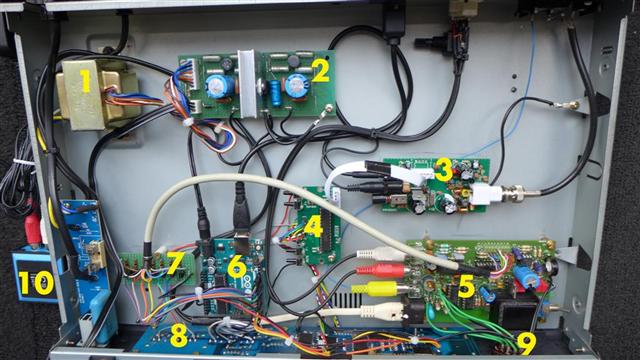
Thus the first BPF reduces the range of voltages presented to the first amplifier and so reduces the chance that the amplifier will distort the desired signal. Another issue with this circuit is that you are modulating the RF frequency with Q1, but the signal on R3 will change if V1 changes, so V1 stability must be very tight or your center frequency will shift with it - probably you should not use a battery (you are also affected by the load on RF out).\) block) to eliminate most of the interfering signals and noise. Once again, in practice the actual capacitance will vary due to traces around the components and component placement. Instead, your resonance should be calculated with L1 and the combination of C4 and C5. Simulate this circuit – Schematic created using CircuitLab In your circuit, C3 is a "decoupling" capacitor and is not part of your resonant circuit calculation at all. Second, I have re-drawn your circuit to make it look more like what is normally seen. But for a four-turn coil, the inductance of the leads and the way they are shaped will create a variance in the coil value, so best to wind one and measure the result, then wind any additional to the same shape and lead lengths and bends. First, your formula should theoretically include the wire diameter, as you have done. How can I calculate the inductor value and the output Rf (frequency) for this circuit?Ĭould someone guide me or give me official documentation? Is frequency resonance is equal to RF out? I read comments on and I "change C5 capacitor for 2-22pf for frequency adjustment," which would suggest that the frequency should be calculated with C5 and not C3 that I use. I'm new to RF and electronics and I'm not sure to use the good capacitor for the calcululation or if I have to take into account the other 10pf capacitors.
#3 transistor fm transmitter software
With my RTL-SDR receiver and GQRX software I find RF signal between 70 and 72 MHz, Sometimes the frequency varies because I work on a breadboard and this is really not suitable (bad connections, noise, frequency change when I touch a wire ( body capacity ) for example and my capacitors do not necessarily have a good tolerance and my inductor is probably not adjusted to the millimeter.) My calculated result is 67.35 MHz (with wire diameter.) I seem close to the signal found. Without wire diameter : Diameter = Air_diameter + (Coil_radius*2)

Print "capacitance : %.12f F" % capacitance_in_farad Print "Inductance : %.12f H" % inductance_in_henry Inductance_in_henry = (inductor/1e6) # to henryĬapacitance_in_farad = (capacitor/1e8) # to faradį0=(W_radians_per_second / (2 * math.pi * math.sqrt((inductance_in_henry * capacitance_in_farad)))) For that I use 'LC' C3 0.01uf and L1 previously calculated (I start and I try to understand current flow, inductance, impedance, magnetic field etc.
#3 transistor fm transmitter code
Which is correct? Does the formula have to include the diameter of the wire, is my code correct?Īlso I tried to calculate the output RF frequency.

The result of my code without the (radius *2) or diameter of the wire : Diameter = Air_diameter On, in comments, 'WH' found approximately 42.74 nH because he not use wire diameter on 'total' diameter.

The inductance of L1 (strip about 4" of 18AWG solid copper wire and wind 4 turns around the threads of a 1/4-20 bolt) is not specified. I am trying to understand this project, simplest FM transmitter:


 0 kommentar(er)
0 kommentar(er)
